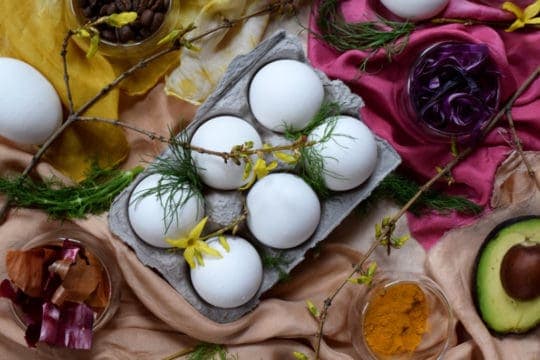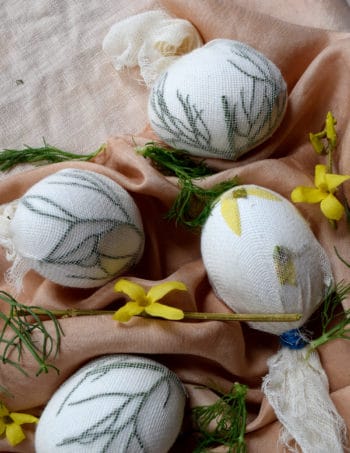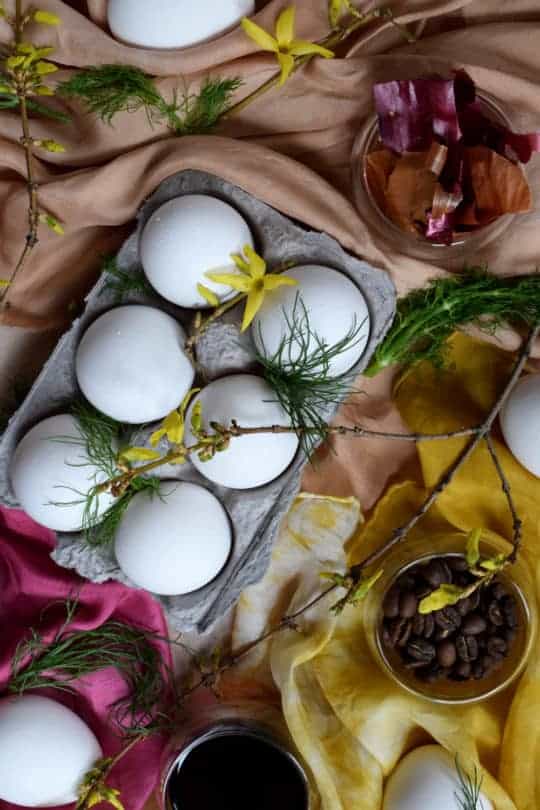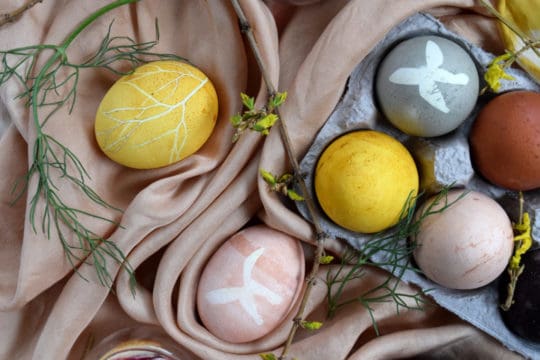Spend $50 and get FREE SHIPPING

The tradition of coloring eggs to celebrate springtime goes back over 60,000 years, pre-dating Christ.Today, colored eggs are a mainstay of the Easter holiday for Christians and non-religious people alike. In fact, between buying colorful plastic eggs, foil wrapped chocolate eggs and bunnies, bags of candy, green plastic grass (check out this DIY compostable alternative!), and all of that Easter ham, Americans are expected to spend a total of $18.2 billion on the holiday this year.
Now, we love any celebration that encourages us to be closer to friends and family and to enjoy time spent together, but we can’t say that we’re huge fans of all of the cheap chocolate, palm-oil filled candies, and plastic accessories that come along with an American Easter celebration. So we went in search of a more natural, less wasteful alternative. It turns out that since people have been coloring Easter eggs for thousands of years, there are some pretty great pre-industrial methods for doing so! We had a blast digging through our kitchen to find fun ingredients for natural dyeing our own Easter eggs and want to share our methods and results with you. If you have little ones, or are perpetually young at heart, we highly recommend this activity as it is hands on and fun without being too messy, dangerous, or remotely expensive. We’ll take this family-friendly activity over plastic eggs any day!

What you’ll need:
• 1 dozen white eggs
• A small pot
• A mesh strainer
• Water
• White vinegar
Basic dye method material options:
• 2 tbsp turmeric powder (for bright yellow)
• 2 cups chopped purple cabbage (for blueish purple)
• 2 cups blueberries, frozen or fresh (for light purple/lavender)
• 1 cup yellow and/or red onion skins (for browns and oranges)
• 2 cups chopped beets (for magenta)
• 2 bags of red tea (for reds and oranges) or black tea (for warm greys and browns)
• 1 cup used coffee grounds (for yellows and browns)
Alternative dye method materials:
• 4 cups leftover red wine (for purple)
• 5 avocado pits (for pink)
• Leaves and/or flowers for resist decorations (for making eco-prints and patterns)
• Cheesecloth or nude pantyhose (a pair you don’t want anymore – for making eco-prints and patterns)


Basic dye method instructions for solid colored eggs
1. Bring a pot of water to boil and place your eggs inside for 8-10 minutes until they are hard boiled. Set aside to cool.
2. Bring 4 cups of water to a boil and add your chosen dye material. Lower heat and let simmer for 15-20 minutes.
3. Strain dye material out of the now-colorful water. Pour dye water into a container large enough to hold a few eggs overnight. Repeat steps 2 & 3 for each dye material you wish to use.
4. Add 2 tbsp white vinegar to each container of dye. If you would like to dye your eggs solid colors only with no patterns, go ahead and add your eggs (gently so they don’t crack) to the different dye containers and let sit overnight. Set aside a few eggs and see alternative methods below if you would like to make some with patterns.
5. If you like the color of your eggs when they are removed from the dye in the morning, you’re done! If you desire a darker color, remove eggs from the dye and rinse lightly under cold water. Then put the eggs and the dye back into your pot and simmer for up to 30 minutes. You can then let the eggs sit in the dye as it cools or for another 24 hours to achieve a stronger color.
Alternative dye methods
Avocado pit dye:
1. Bring 6 cups of water to a boil, add avocado pits then lower to a simmer. Let simmer for 1-2 hours, making sure that the water does not all boil away (you can add more water if it starts to get too low, don’t worry this will not dilute the dye).
2. Remove pits from the dye and simmer for another 1-2 hours. The dye will become a dark, rusty red.
3. Add boiled eggs to the dye and simmer for 15 minutes. Let dye and eggs cool together before adding both to a container where they can sit overnight. Eggs should sit in avocado pit dye for at least 5 hours to achieve a light, blush pink. Let eggs sit in avocado pit dye for longer to achieve darker shades of orangey-rosey pinks.
*
psssst did you know that you can use avocado pits to dye your clothes, too?? Check out the recipe here!
Red wine dye:
1. Place 4 cups red wine and boiled eggs in a container to steep. Stir occasionally.
2. Eggs should sit in the wine dye for 5 hours to achieve a light purple. Let eggs sit in the wine dye for longer to achieve darker, more dramatic shades of purple.
Making eco-prints with flowers and leaves:
1. Cut approx 4×4” squares from cheesecloth or cut 4” sections from pantyhose (the toes work really well!).
2. One boiled egg at a time, arrange leaves and flowers to lay flat against the egg in the desired pattern. Secure the design by wrapping the egg along with leaves and flowers tightly in cheesecloth or pantyhose.
3. Pull cheesecloth/pantyhose tight and secure loose ends with a rubberband.
4. Place patterned eggs in natural dye bath as instructed above. Remove cheesecloth/pantyhose and eco-print materials only after you have achieved your desired color and the egg is dry.

